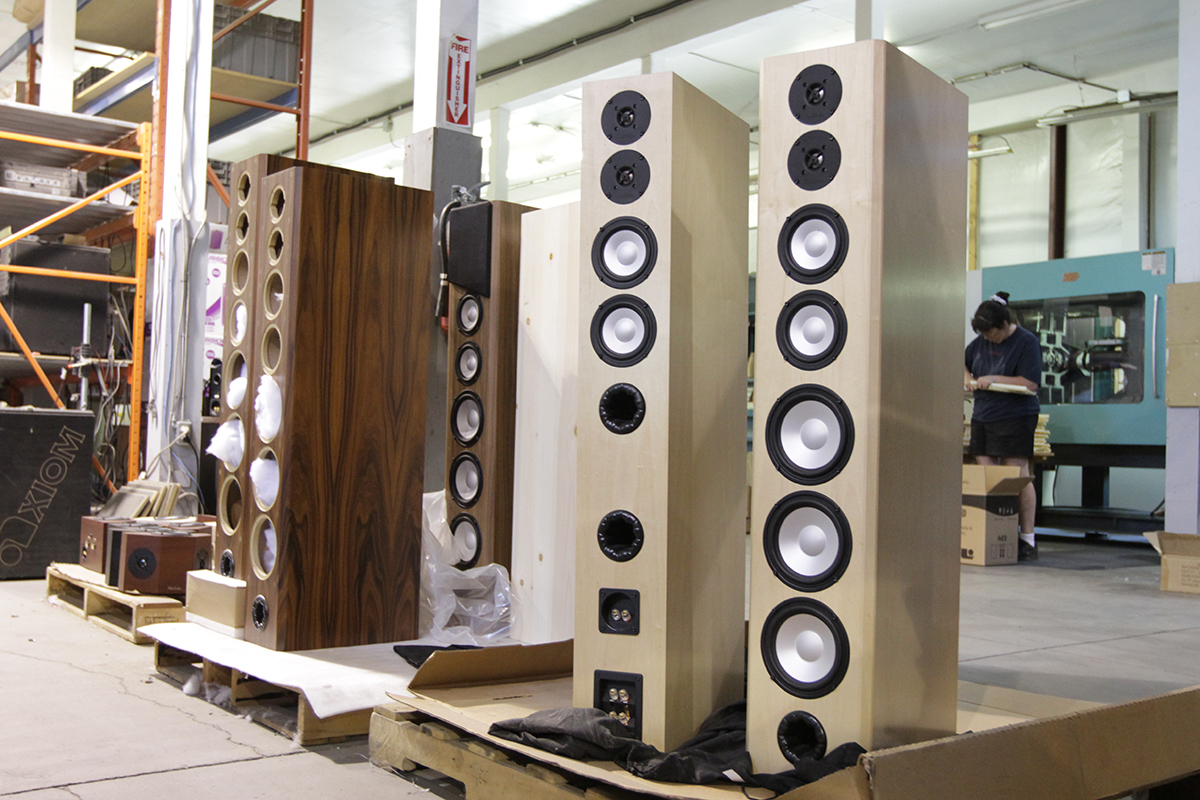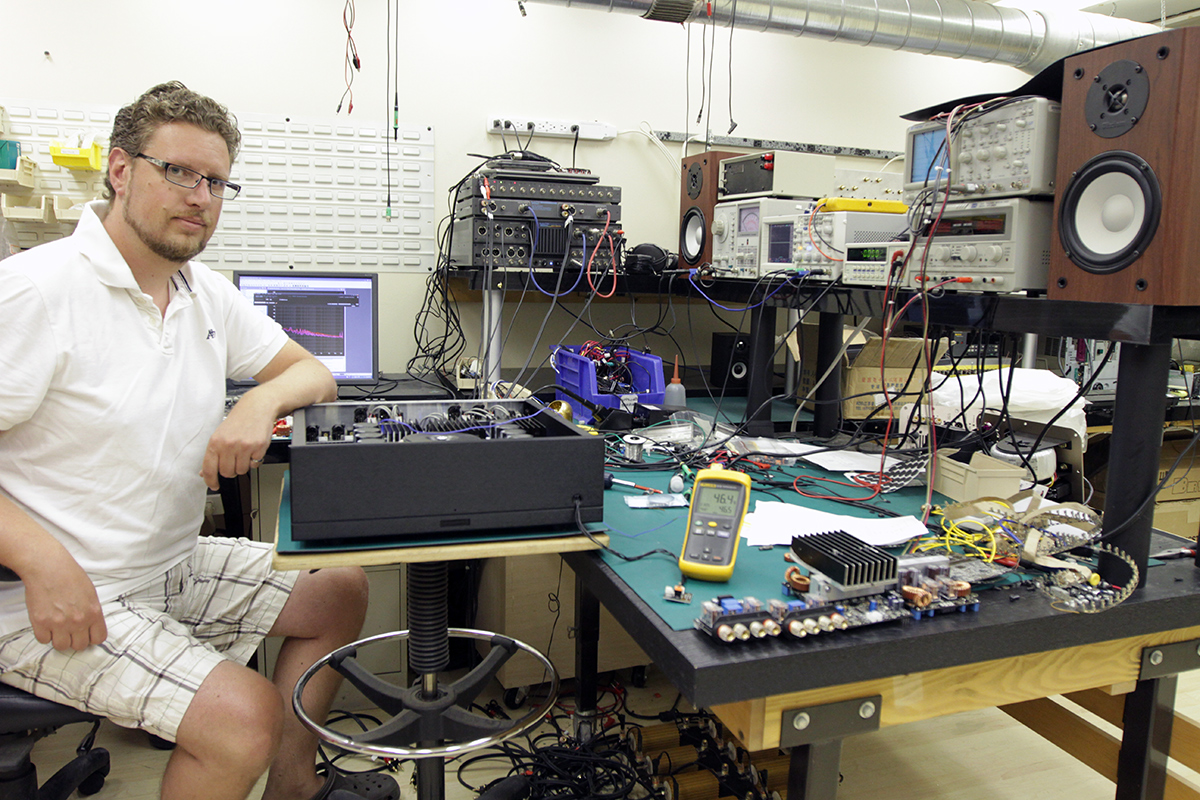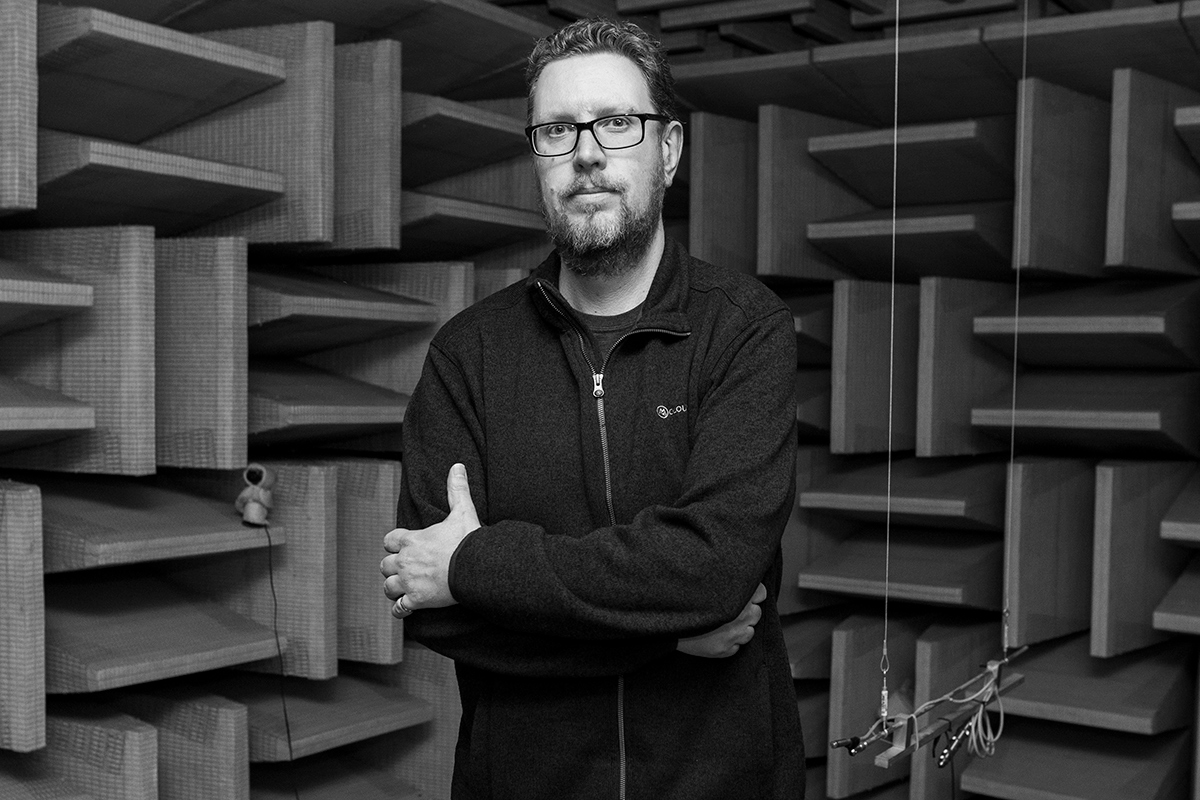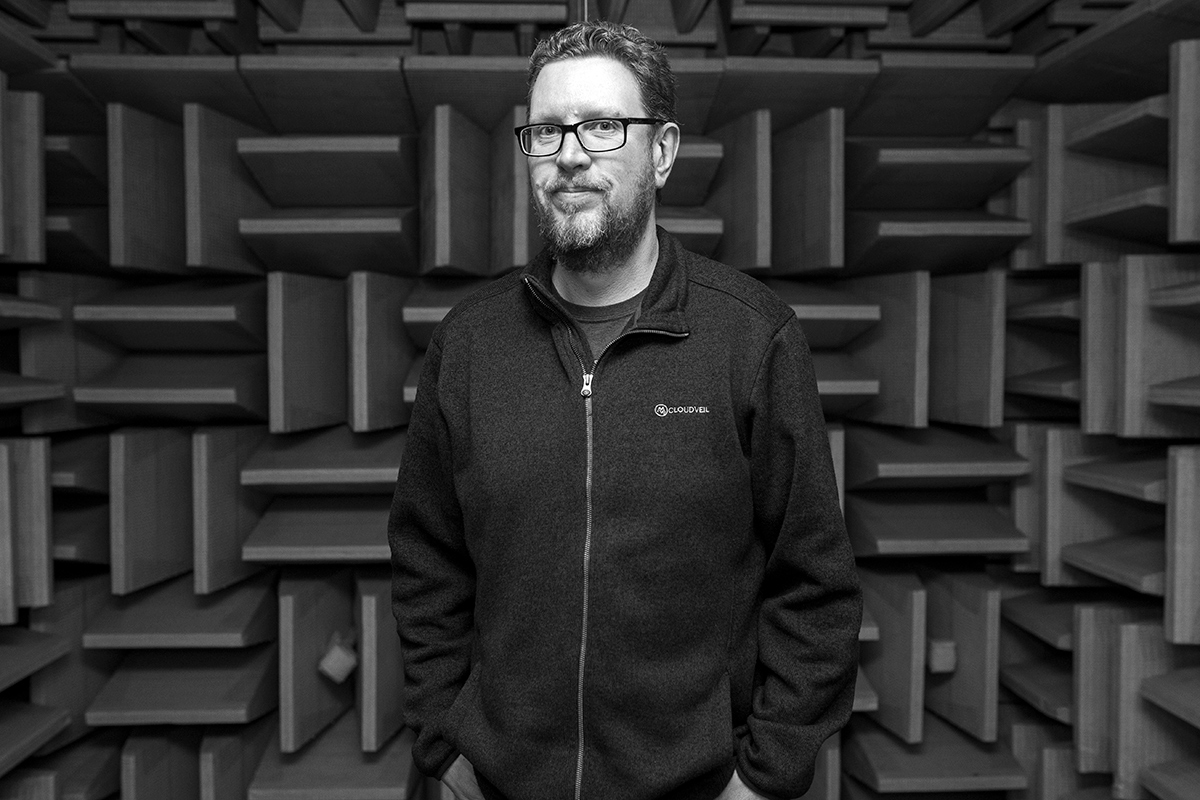Most active speakers are all-in-one components, with built-in amplifiers and often built-in DACs as well, but no law says that active loudspeaker technology must be neat and compact. It’s possible to create an active speaker system with external amplifiers and crossover, like those offered by Bryston. Bryston’s active systems combine crossoverless versions of its Model T, Middle T, and Mini T speakers with the BAX-1 external crossover, plus amplifiers dedicated to each frequency range.
It’s fairly widely known that Bryston’s speakers, whether passive or active, are actually manufactured by Axiom Audio in Dwight, Ontario, and that Axiom is closely involved in their design. What’s less widely known is that Axiom played a role in the design of Bryston’s digital crossover. As Andrew Welker, Axiom’s manager of R&D, relates in the following interview, Bryston designed the electronics for the BAX-1, but relied on Axiom to choose the digital signal processors (DSPs) and write the code.
In addition to the digital crossover, Bryston’s active speaker systems require six channels of amplification, placing them at the opposite end of the spectrum of domestic gear normally reviewed on SoundStage! Simplifi. However, Bryston’s Middle T Active system was recently reviewed on SoundStage! Hi-Fi by Roger Kanno.
As Welker outlines, Axiom is preparing to introduce even more ambitious -- and sprawling -- active speaker systems under its own name. The company plans to launch active versions of its LFR omnidirectional speakers, which have drivers on their front and rear panels. In addition to a DSP-based controller, those systems will need ten channels of amplification.
 The Axiom Audio LFR1100, when it was first introduced in 2012
The Axiom Audio LFR1100, when it was first introduced in 2012
DSP is integral to the LFR series, because it processes the sound differently for the front and rear drivers, to prevent the diffuse imaging produced by many omnidirectional speakers. Welker learned about these problems earlier in his career, when he worked for the now-defunct Audio Products International, where his responsibilities grew to include API’s Mirage brand. Mirage’s flagship models were the M1 and M3 floorstanders, both of them wide-baffled bipolar designs with drivers at front and rear.
Another recent Axiom initiative is its Wireless series of powered speakers, all of which work with a companion wireless transmitter. Introduced in 2018, these products are clearly intended to make hi-fi home friendly. That’s where my conversation with Welker began.
Gordon Brockhouse: Last year, Axiom launched powered versions of several bookshelf speakers and floorstanders, as well as subwoofers. What had led to that?
Andrew Welker: We’d been getting requests for this kind of speaker for years. The number-one driver was the wireless portion: getting rid of the cable. There are lots of applications like condos, which have concrete walls. People don’t want to see wires, but there’s no way to hide wires in the wall. Then there are applications where people just want to put the speakers wherever they want, and not worry about terminating cables.
Our wireless speakers can work with a standalone transmitter that has one pair of RCA inputs, and plugs into the analog output of a receiver or preamplifier. But most customers are buying our four-in-one transmitter, which has analog and optical inputs, plus Wi-Fi and Bluetooth. It supports AirPlay and Spotify Connect, and can also stream music from a network or USB drive.
I’d been hesitant about doing a product like this, because there hadn’t been a reliable wireless solution. Over the years, we’d looked at a lot of evaluation kits and talked to a lot of companies. Most of those systems were lacking in fidelity, robustness, or both. With some systems, if you walked between the transmitter and the speakers, the signal would drop out completely. Synchronization between channels was a major issue. With some of these systems, you’d actually get a wandering image.
The system we’re using now is based on a chipset from Texas Instruments. Synchronization between channels is within microseconds. It runs in the 2.4GHz band -- that’s the same wheelhouse as Wi-Fi, but it’s not Wi-Fi. It’s got a bunch of cool stuff, like spread-spectrum and frequency-hopping. We took the chipset and best practices for the RF portion from TI, and built all the circuitry around it ourselves.
The transmitter sends 16-bit/48kHz audio to receivers in each speaker. It’s a proprietary link format, with control signals riding on top of PCM. It’s a full-duplex system. The transmitter and each speaker talk to each other constantly. A stereo bitstream is sent to each speaker. The hardware in each speaker decides what channel to pull from the bitstream. You can have up to four receivers per transmitter. That could be two pairs of speakers, or a pair of speakers plus one or two subwoofers.
GB: These are powered speakers, as opposed to active speakers, right?
AW: Yes. Each model has an internal crossover identical to the passive model on which it’s based, plus a single-channel amplifier. Most of the customers asking for the product appreciate good audio, but they’re not necessarily audiophiles. So we focused our time and money on the wireless aspect, then used our existing amplifier and speaker platforms. For the price points we wanted, we provided as much amplifier power as we could.
Most companies building this kind of product buy off-the-shelf amplifiers from suppliers like BASH, Hypex, or ICEpower. Axiom doesn’t outsource any components -- we build and design the amplifiers ourselves. They’re all pulse-width-modulation designs. We make the circuit boards, and they’re stuffed in Toronto. We have three platforms, depending on the model of speaker. Our smallest bookshelf speaker, the M3, has a single-chip, 60W class-D amplifier. With the M5HP three-way bookshelf and M80 tower, we step up to a component-level 200W class-D design. The M80 is available in a high-power version with a bridged version of that amplifier, which gives you 600W -- the same as on our flagship, the M100 tower. That’s a lot of juice.
GB: How do you view the trade-offs between powered and active speakers?
AW: As you know, Axiom works closely with Bryston. We build their speakers, and we were closely involved in the design of those products. This relationship started when [Bryston VP] James Tanner came to us, saying he wanted a fully active speaker as his personal reference. Funnily enough, that morphed into us building a whole line of passive speakers for Bryston.
After these speakers attracted good press and lots of happy customers, James decided to look at doing a fully active version of the Model T. Collectively, we decided on a family of DSPs for the active crossover. Bryston did the electronics design -- buffers, output stages, power supply. We wrote the code. Bryston’s active series has been amazingly successful -- beyond anybody’s expectations.
GB: It’s an unusual approach -- with an external crossover connected to power amplifiers driving separate frequency bands in the speakers, which themselves have no crossover.
AW: Yes. I find it mystifying that active speakers, whether it’s a self-contained speaker with internal crossovers and amplifiers, or an active system with external crossover and amplifiers, don’t seem to get any traction from the audio-buying public. As an electronics designer, that’s always been a head-scratcher for me. Getting rid of that passive crossover network is hugely beneficial, particularly in the low-frequency section where you’ve got sizable inductors, which are nonlinear devices, in series with the output of your amplifier. Getting rid of those devices gives the amplifier way more control over the drive-unit.
 Andrew designing an Axiom Audio amplifier
Andrew designing an Axiom Audio amplifier
GB: Given these advantages, why hasn’t Axiom done any active speakers?
AW: Actually, we’ve had customers ask us about doing a fully active version of our flagship omnidirectional product, the LFR series. Some customers have already plunked their money down and are ready to buy it. It will come out this year.
Our LFR speakers have drivers on the front and rear. They’re sold with a DSP unit that tailors the sound separately for the front and rear sections. That means each section needs its own amplifier.
Most customers will scratch their heads when you tell them they need four amplifier channels to drive a pair of stereo speakers. Then I explain what the problems are. Not only is the timing of the rear section important, so is the frequency response and its relationship to the frequency response of the front section. Depending on the depth of the cabinet, you get a very bad cancellation at some frequencies, because of the different arrival times based on the relationship between the wavelength and the depth of the box.
Before joining Axiom, I worked for years at API [Audio Products International], where I headed up the Mirage line. At Mirage, we called this problem “wraparound cancellation.” I actually bought a pair of Mirage M3 bipolar speakers as I was finishing high school. They were tonally a little dark. While they were big-sounding, they didn’t image very well. In the wrong environment, you got the 20-foot-wide-piano effect.
One of the reasons Mirage shifted to omnipolar technology was to move away from problems inherent to the front-driver/back-driver array used on bipolar models like the M1 and M3. On the original Mirage bipolar models, those cancellations occurred at a couple of different frequencies. One of them was smack dab in the midrange. That was the reason for the dark quality and lack of image focus. It was too difficult to make the front and back do what you wanted when you had to drive a fully passive speaker with one amplifier.
When I started working here, [Axiom president] Ian Colquhoun asked me for my thoughts on doing an omnidirectional speaker for Axiom: “Is there anything you would do differently?” I told him, “We have DSP now. It’s relatively inexpensive, and it’s really high quality." On the DSPs for the LFRs, we’re running at 24/96. We can tailor the front and back responses of these speakers any way we wish. If the recording has a good sense of space, you’ll get loads of spaciousness, with good image focus. It’s the best of both worlds, which is why customers who love that product are asking for more.
We’ve had customers saying to us, “I’ve got your best speakers and your best four-channel amplifier for running those omnidirectional speakers. Is there anything you can do to top that? Have you ever thought of doing a fully active system?” Ian was already thinking of doing a system like that for his personal use. So fully active versions of our LFR speakers are in the works now. Each speaker needs five channels of amplification, to power a three-way section on the front and a two-way section on the back. We also need five channels of DSP per speaker.
Not wanting to do anything lightly, Ian has also tasked me with designing a more powerful version of our most powerful amplifier. So we’re looking at taking the basics of our two-channel ADA150 amplifier and making a bridged version, which will be rated around 1500W. That will drive the triple-woofer section of the LFR speaker.
As soon as the DSP portion is done, Ian is going to start working on the acoustic portion. Based on what we’ve done for Bryston, I think he has a good handle on what he wants to do. The amplifier will follow. And once that’s ready, this will all go into one big, very expensive, very high-quality system. The price will be in the $20k neighborhood. This is about as extreme as it gets. The system will have lots of boxes and lots of cables, but we’ve had people practically begging us for this.
GB: Do you have any plans for self-contained active speakers?
AW: We’ve talked about this. There’s been some desire to do active professional monitors. It will probably happen at some point. Once we have experience with the active LFR models, this is just a natural step. We have the skills and electronics available. When word gets out about our active LFR systems, I wouldn’t be surprised if people start asking for active versions of other speakers in our line.
GB: Do you think people are becoming more open to the idea of active speakers?
AW: There are two answers to that question. Most people who think of themselves as audiophiles will never accept it. To many people, audio is a hobby, like classic cars. Every year they want to upgrade or change something -- chrome-plated head covers, or a new distributor to tweak the timing. They like playing with stuff.
Many audiophiles are similar. They love messing around with hardware, with cables. They like making themselves feel good by buying the latest tweak and believing it makes a difference -- whether it does or not. For those people, self-contained active speakers take away part of the joy of audio.
However, digital and streaming are now part of the audiophile mainstream, which I find surprising. I would have thought audiophiles would stay with packaged media, so they could be sure of the quality they’re getting. But companies like Bryston and NAD are bringing these people around with high-end streamers and servers. As audiophiles get more comfortable with technology outside their comfort zone, maybe they will accept active speakers.

I think the broader appeal for active products is with Wi-Fi-enabled speakers from companies like Bose and Sonos and, of course, Axiom. They tell their customers, “Here’s this box. Put it on your computer network and download an app, and you can play everything you ever wanted to listen to.” People are embracing that like gangbusters.
A lot of people want sound quality as well as convenience. I think many non-audiophiles are going to embrace active loudspeakers, because that’s what they want from a convenience standpoint. As that occurs, maybe audiophiles will accept them as well.
. . . Gordon Brockhouse




